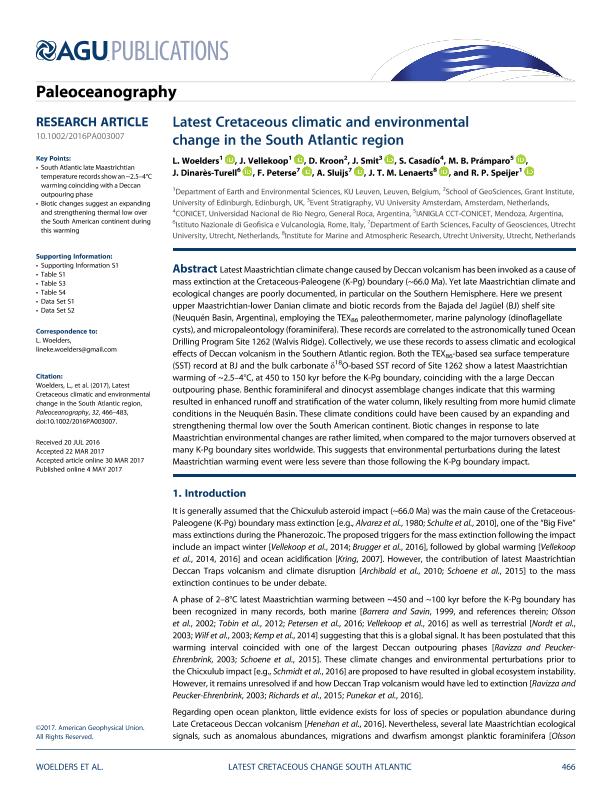Mostrar el registro sencillo del ítem
dc.contributor.author
Woelders, Lineke

dc.contributor.author
Vellekoop, Johan

dc.contributor.author
Kroon, D.
dc.contributor.author
Smit, Jan

dc.contributor.author
Casadio, Silvio Alberto

dc.contributor.author
Pramparo, Mercedes Beatriz

dc.contributor.author
Dinarès Turell, Jaume

dc.contributor.author
Peterse, Francien

dc.contributor.author
Sluijs, Appy

dc.contributor.author
Lenaerts, Jan

dc.contributor.author
Speijer, Robert

dc.date.available
2018-12-20T20:27:31Z
dc.date.issued
2017-05
dc.identifier.citation
Woelders, Lineke; Vellekoop, Johan; Kroon, D.; Smit, Jan; Casadio, Silvio Alberto; et al.; Latest Cretaceous climatic and environmental change in the South Atlantic region; American Geophysical Union; Paleoceanography; 32; 5; 5-2017; 466-483
dc.identifier.issn
0883-8305
dc.identifier.uri
http://hdl.handle.net/11336/66879
dc.description.abstract
Latest Maastrichtian climate change caused by Deccan volcanism has been invoked as a cause of mass extinction at the Cretaceous-Paleogene (K-Pg) boundary (~66.0 Ma). Yet late Maastrichtian climate and ecological changes are poorly documented, in particular on the Southern Hemisphere. Here we present upper Maastrichtian-lower Danian climate and biotic records from the Bajada del Jagüel (BJ) shelf site (Neuquén Basin, Argentina), employing the TEX86 paleothermometer, marine palynology (dinoflagellate cysts), and micropaleontology (foraminifera). These records are correlated to the astronomically tuned Ocean Drilling Program Site 1262 (Walvis Ridge). Collectively, we use these records to assess climatic and ecological effects of Deccan volcanism in the Southern Atlantic region. Both the TEX86-based sea surface temperature (SST) record at BJ and the bulk carbonate δ18O-based SST record of Site 1262 show a latest Maastrichtian warming of ~2.5–4°C, at 450 to 150 kyr before the K-Pg boundary, coinciding with the a large Deccan outpouring phase. Benthic foraminiferal and dinocyst assemblage changes indicate that this warming resulted in enhanced runoff and stratification of the water column, likely resulting from more humid climate conditions in the Neuquén Basin. These climate conditions could have been caused by an expanding and strengthening thermal low over the South American continent. Biotic changes in response to late Maastrichtian environmental changes are rather limited, when compared to the major turnovers observed at many K-Pg boundary sites worldwide. This suggests that environmental perturbations during the latest Maastrichtian warming event were less severe than those following the K-Pg boundary impact.
dc.format
application/pdf
dc.language.iso
eng
dc.publisher
American Geophysical Union

dc.rights
info:eu-repo/semantics/openAccess
dc.rights.uri
https://creativecommons.org/licenses/by-nc-sa/2.5/ar/
dc.subject
Maastrichtian
dc.subject
Oxygen Isotopes
dc.subject
Paleoclimate
dc.subject
Paleoenvironment
dc.subject
South Atlantic
dc.subject
Tex86
dc.subject.classification
Meteorología y Ciencias Atmosféricas

dc.subject.classification
Ciencias de la Tierra y relacionadas con el Medio Ambiente

dc.subject.classification
CIENCIAS NATURALES Y EXACTAS

dc.title
Latest Cretaceous climatic and environmental change in the South Atlantic region
dc.type
info:eu-repo/semantics/article
dc.type
info:ar-repo/semantics/artículo
dc.type
info:eu-repo/semantics/publishedVersion
dc.date.updated
2018-10-23T20:16:15Z
dc.journal.volume
32
dc.journal.number
5
dc.journal.pagination
466-483
dc.journal.pais
Estados Unidos

dc.journal.ciudad
Washington DC
dc.description.fil
Fil: Woelders, Lineke. Katholikie Universiteit Leuven; Bélgica
dc.description.fil
Fil: Vellekoop, Johan. Katholikie Universiteit Leuven; Bélgica
dc.description.fil
Fil: Kroon, D.. University of Edinburgh; Reino Unido
dc.description.fil
Fil: Smit, Jan. University of Amsterdam; Países Bajos
dc.description.fil
Fil: Casadio, Silvio Alberto. Consejo Nacional de Investigaciones Científicas y Técnicas. Centro Científico Tecnológico Conicet - Patagonia Norte. Instituto de Investigación en Paleobiología y Geología; Argentina. Universidad Nacional de Río Negro; Argentina
dc.description.fil
Fil: Pramparo, Mercedes Beatriz. Consejo Nacional de Investigaciones Científicas y Técnicas. Centro Científico Tecnológico Conicet - Mendoza. Instituto Argentino de Nivología, Glaciología y Ciencias Ambientales. Provincia de Mendoza. Instituto Argentino de Nivología, Glaciología y Ciencias Ambientales. Universidad Nacional de Cuyo. Instituto Argentino de Nivología, Glaciología y Ciencias Ambientales; Argentina
dc.description.fil
Fil: Dinarès Turell, Jaume. Istituto Nazionale di Geofisica e Vulcanologia; Italia
dc.description.fil
Fil: Peterse, Francien. University of Utrecht; Países Bajos
dc.description.fil
Fil: Sluijs, Appy. University of Utrecht; Países Bajos
dc.description.fil
Fil: Lenaerts, Jan. University of Utrecht; Países Bajos
dc.description.fil
Fil: Speijer, Robert. Katholikie Universiteit Leuven; Bélgica
dc.journal.title
Paleoceanography

dc.relation.alternativeid
info:eu-repo/semantics/altIdentifier/doi/https://dx.doi.org/10.1002/2016PA003007
dc.relation.alternativeid
info:eu-repo/semantics/altIdentifier/url/https://agupubs.onlinelibrary.wiley.com/doi/abs/10.1002/2016PA003007
Archivos asociados
